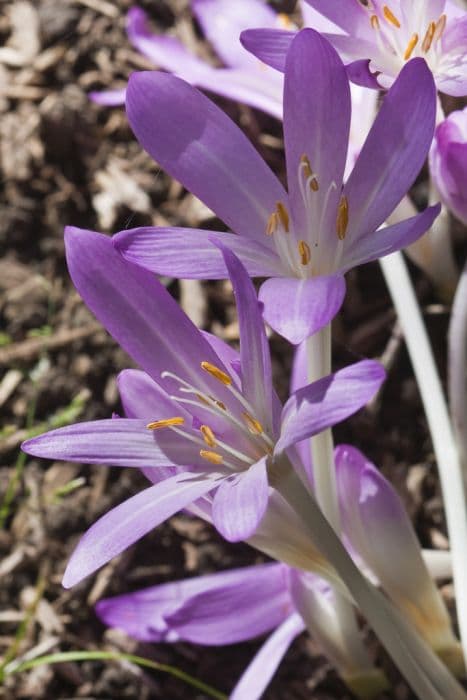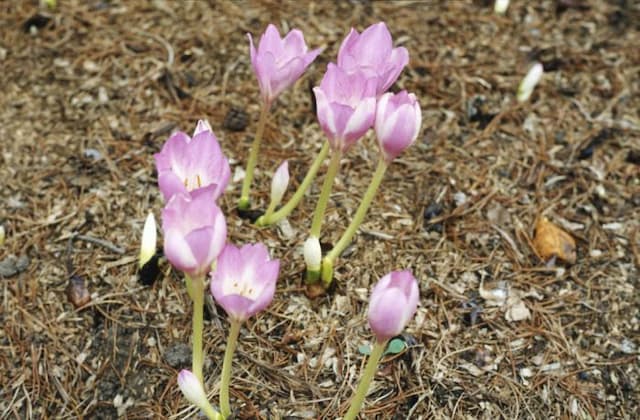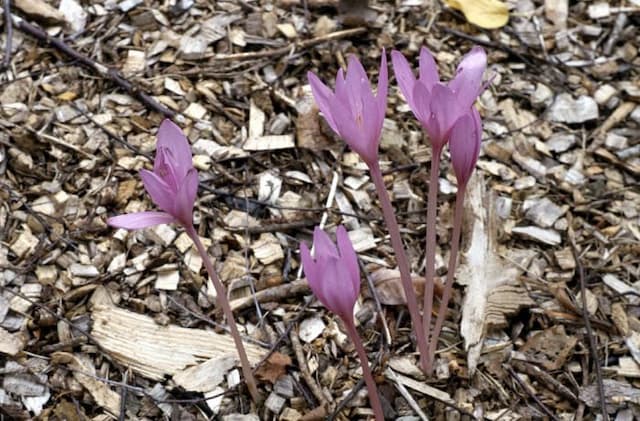Bivon's Crocus Colchicum bivonae

ABOUT
Colchicum bivonae, commonly known as the autumn crocus, is a flowering plant that is part of the lily family. This perennial plant is known for its striking blooms that appear in the fall. It produces funnel-shaped flowers that come in a beautiful lilac or light purple color, with a white throat. The blooms have six petal-like tepals which spread outwards and can appear singly or in small clusters above the ground. The plant has a unique life cycle in that its flowers emerge in the autumn without any accompanying foliage; the leaves only appear after the flowering period, typically in the spring. These leaves are broad and elliptical, with a glossy green color and may have a somewhat fleshy texture. They form a rosette at the base of the plant, surrounding the flowering stalks. The autumn crocus also bears capsuled fruit, but it's often unseen, as it develops at or beneath the soil surface after the flowers have faded. The seeds within are typically dispersed by the time the leaves fully develop in the spring. It is important to note that this plant can be easily mistaken for true crocuses, which bloom around the same time, but they are not closely related. While they share a similar color and form, the autumn crocus is distinctive for its larger size flower and later blooming season. Enthusiasts cherish the autumn crocus for its vibrant autumnal bloom, often at a time when many other plants are preparing to enter dormancy. Its sudden floral display provides a welcome splash of color in gardens and landscapes as the colder weather approaches. Despite its beauty, it's worth noting that the autumn crocus is known to be toxic, and care should be taken around pets and children.
About this plant
 Names
NamesFamily
Colchicaceae
Synonyms
Sicilian Autumn Crocus
Common names
Colchicum bivonae Guss.
 Toxicity
ToxicityTo humans
Colchicum bivonae, most commonly known as autumn crocus, contains toxic alkaloids such as colchicine. All parts of the plant are poisonous to humans, and ingestion can lead to serious health consequences. Symptoms of poisoning can include gastrointestinal distress such as nausea, vomiting, and diarrhea; organ failure involving the kidneys, liver, and lungs; bone marrow suppression; and multi-organ failure. In severe cases, ingestion of autumn crocus can be fatal.
To pets
Autumn crocus is toxic to pets, including dogs and cats, due to the presence of colchicine and other alkaloids. If a pet ingests any part of the plant, they might show symptoms like drooling, vomiting, gastrointestinal bleeding, severe diarrhea, respiratory difficulties, seizures, liver and kidney damage, and even death in severe cases. Immediate veterinary attention is crucial if autumn crocus poisoning is suspected.
 Characteristics
CharacteristicsLife cycle
Perennials
Foliage type
Deciduous
Color of leaves
Green
Flower color
Pink
Height
6 inches (15 cm)
Spread
6 inches (15 cm)
Plant type
Bulb
Hardiness zones
7
Native area
Mediterranean
Benefits
 General Benefits
General Benefits- Ornamental Value: Colchicum bivonae adds visual interest to gardens with its bright pink to purple flowers that bloom in autumn.
- Drought Tolerance: Once established, it is relatively drought-resistant, needing minimal watering in well-drained soil.
- Pest Resistance: This plant is not commonly affected by pests, reducing the need for chemical treatments.
- Low Maintenance: Being a hardy perennial, Colchicum bivonae requires little care once planted, making it a good choice for low-maintenance landscaping.
- Naturalizing: It can spread and naturalize in an area, creating a large display over time.
- Seasonal Interest: With its autumn blooming, it provides a splash of color when many other plants are beginning to fade.
 Medical Properties
Medical PropertiesThis plant is not used for medical purposes.
 Air-purifying Qualities
Air-purifying QualitiesThis plant is not specifically known for air purifying qualities.
 Other Uses
Other Uses- Ornamental purposes: Colchicum bivonae, commonly known as autumn crocus, is often used in gardens and landscapes for its attractive, vibrant pink to purplish flowers that bloom in the fall.
- Education and research: The autumn crocus can be utilized in educational settings such as botanical gardens and university courses to teach about plant biology and the Liliaceae family.
- Photography subject: The distinctive flowers of the autumn crocus make it a favorite subject for nature photographers and flower enthusiasts.
- Ecological studies: As part of local flora, Colchicum bivonae can serve as an indicator species in ecological studies concerning biodiversity and habitat conditions.
- Artistic inspiration: The unique appearance of the autumn crocus can provide inspiration for artists and craftspeople in creating plant-themed artwork, textiles, and designs.
- Culinary decoration: Although it is not edible, the flower of the autumn crocus can be used as a temporary decorative element on plates in high-end culinary presentations.
- Bee forage: While in bloom, the autumn crocus can provide a source of nectar for bees and other pollinators during the fall season.
- Cultural significance: In some regions, the autumn crocus can hold cultural significance and be part of traditional festivals or celebrations heralding the arrival of autumn.
- Study of plant pigments: The vivid colors of Colchicum bivonae flowers can be used to study plant pigments and their role in attracting pollinators.
- Gifting: As a symbol of the changing seasons, the autumn crocus can be a thoughtful gift for gardeners and nature lovers during the fall time.
Interesting Facts
 Feng Shui
Feng ShuiThe plant_name is not used in Feng Shui practice.
 Zodiac Sign Compitability
Zodiac Sign CompitabilityThe plant_name is not used in astrology practice.
 Plant Symbolism
Plant Symbolism- Endurance: Colchicum bivonae, more commonly referred to as autumn crocus, often symbolizes endurance due to its ability to survive and bloom in the cooler, harsher conditions of autumn when most other plants are ending their life cycles.
- Rebirth: The autumn crocus is also a symbol of rebirth and new beginnings because it emerges in a season that typically signifies the end of the growing period, reminding us of the cycle of life and the return of life after dormancy.
- Time and Patience: Since Colchicum bivonae follows an unusual growth pattern, blooming in autumn but not producing foliage until the following spring, it represents the idea of time and patience, and the understanding that everything has its perfect moment.
 Water
WaterSicilian honey garlic should be watered moderately, making sure the soil is moist but not waterlogged, as they prefer well-draining conditions. Watering once a week with about 1 gallon of water should suffice, but always check the top inch of soil for dryness before watering. During the dormancy period in summer, reduce watering significantly to mimic the natural dry season it experiences in its habitat. It is important to avoid standing water to prevent bulb rot.
 Light
LightSicilian honey garlic thrives best in full sun to partial shade. Find a spot where the plant can receive at least six hours of sunlight daily. If growing indoors, ensure the plant is placed by a window that allows ample light, but protect it from harsh, direct midday sunlight which might scorch the leaves.
 Temperature
TemperatureSicilian honey garlic prefers temperatures ranging between 50°F and 77°F, with an ideal temperature around 70°F. It can tolerate brief periods of colder weather down to 20°F and should be protected from extreme cold. Ensure the plant is not exposed to temperatures above 77°F for prolonged periods as it may induce stress.
 Pruning
PruningPrune Sicilian honey garlic to remove spent blooms and yellow or damaged leaves to encourage healthy growth and prevent disease. Pruning is typically done after flowering, usually in late spring or early summer. Deadheading the flowers after they have faded can also help redirect energy back to the bulb for the next season's growth.
 Cleaning
CleaningAs needed
 Soil
SoilThe Sicilian autumn crocus (Colchicum bivonae) prefers a well-draining soil mix, rich in organic matter, with a neutral to slightly alkaline pH of around 7.0 to 7.5. A mixture of loam, peat, and sharp sand is ideal, ensuring adequate drainage and fertility.
 Repotting
RepottingSicilian autumn crocus should be repotted every 3-4 years to refresh the soil, usually after flowering has finished and leaves have died back.
 Humidity & Misting
Humidity & MistingSicilian autumn crocus thrives in average room humidity. It does not require high humidity levels but should be protected from extremely dry air.
 Suitable locations
Suitable locationsIndoor
Place in bright, indirect light with well-draining soil.
Outdoor
Plant in partial shade, well-draining soil, protect from intense sun.
Hardiness zone
7-10 USDA
 Life cycle
Life cycleColchicum bivonae, commonly known as the Sicilian Autumn Crocus, undergoes a seasonal life cycle characterized by a series of growth stages. In late summer to early fall, it produces vibrant purple-pink flowers directly from the underground corm as it enters its flowering stage without any foliage present. After the flowering phase, foliage begins to develop in the form of elongated green leaves during fall, which photosynthesize and provide energy for the corm to grow and store nutrients. Throughout the winter, the plant is dormant, and the leaves die back; the corm rests underground. In spring, the corms give rise to a new set of leaves, continuing to gather and store energy but the plant does not flower in this season. Finally, the leaves wither away as the plant re-enters dormancy during the warm summer months before the cycle restarts with the next flowering phase.
 Propogation
PropogationPropogation time
Spring-summer
Colchicum bivonae, commonly referred to as Autumn Crocus, is typically propagated by dividing its corms. The best time to propagate this plant is in late summer after the leaves have died back. To propagate, first, unearthen the corms from the soil and brush off any excess dirt. You’ll notice that the parent corm may have produced smaller cormels around its base. Carefully separate these cormels from the parent corm. It is essential to wait until the cormels are large enough, generally at least 1/3 inch in diameter. Once separated, the cormels can be planted immediately in well-draining soil at a depth of about 3 to 4 inches (7.5 to 10 cm) and spaced approximately 6 inches (15 cm) apart. It is crucial to handle corms gently as they are prone to damage, which can lead to disease. Keep the soil moist until the cold weather sets in, but do not overwater as this can also lead to rot. With proper care, the new corms will establish and bloom in the following autumn.









